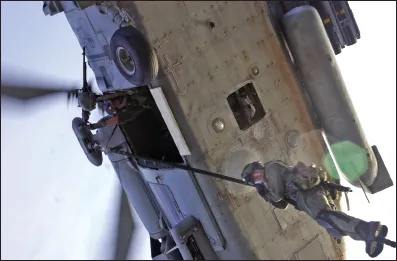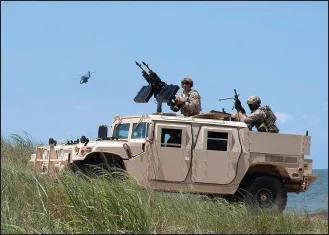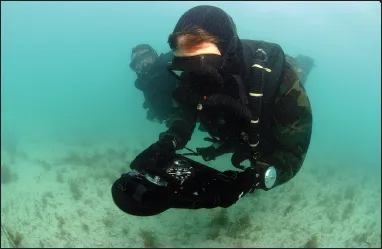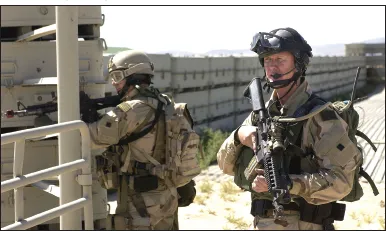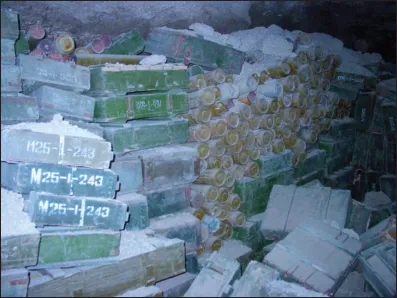![]()
1
WHO ARE THESE AMERICANS?
In October 2011, two relief workers, American Jessica Buchanan and Poul Hagen Thisted were kidnapped at gunpoint by Somali pirates, betrayed by their security adviser who had arranged for them to be abducted. For three months they were held hostage while the pirates demanded ransom. Fed only enough to be kept alive and forced to sleep on mats in the open desert, Buchanan fell ill from a thyroid condition that caused a serious kidney ailment. Stuck in a compound, the hostages had no way of knowing whether anyone even knew they had been kidnapped, let alone whether the ransom would be paid.
*****
The pirates around her were dead-to-the-world asleep when Buchanan rose to go to the bathroom in the bush. She had no sooner laid down again when she heard gunfire followed by voices—American voices—calling her name, Jessica, and yanking her out of sleep. The voices don’t jibe with what she knows: She is in Somalia in a compound. She has been a hostage of Somalian pirates for three months. She is very ill.
She pulls her blanket more snugly over her, but the voices persist, telling her that they are with the American military, that she is safe, and that they are going to take her home.
With no time to spare, one of the military men picks her up and begins to run. It is pitch dark. Eventually he stops and puts her down. They give her food, water, and medicine, and form a ring around her to keep her safe until the helicopters come. At one point, one of the men runs back to get a ring that belonged to her mother that she had hidden—in the hubbub she had left it behind.
Jessica flew off in one helicopter; the members of SEAL Team Six left in another. She never saw their faces and never knew their names, but to these men who did not know her, this young woman was the most precious thing at that moment, her life more important than their own.
*****
When members of SEAL Team Six shot and killed Osama bin Laden inside a private residential compound in Abbottabad, Pakistan, on May 2, 2011, the news electrified the world and millions watched as President Obama made the announcement that the man responsible for the World Trade Center attack on 9/11 was dead. It is more than likely that fewer people followed the story of Jessica Buchanan.
U.S. Navy SEALs with Special Operations Task Force-South shield themselves from dust and rocks as an MH-47 Chinook takes off after a clearing operation in the Panjwai district of Kandahar province, Afghanistan.
Credit: U.S. Army photo by Sgt. Daniel P. Shook/Released.
In January 2012, some dozen men from Seal Team Six parachuted from an Air Force Special Operations aircraft to a location two miles from where Buchanan, 32, and Thisted, 60, who had been working for a Danish relief organization helping to remove mines in war-torn areas in Somalia, were being held. The commandos made their way to the compound in the dark, and surprised the captors, who had been asleep. For Buchanan, it was a miracle that so much military manpower would be exerted to save a lowly aid worker. But to the SEALs, the mission to save her was as important as any, and only one of the many that come under the designation “Special Operations”—what we often hear called Special Ops or SPECOPS.
During an interdiction operations exercise in the Arabian Sea, U.S. Navy SEALs fast-rope to the bridge-wing aboard USS Shreveport from an HH-60H Seahawk helicopter assigned to the Dragon Slayers of Helicopter Anti-Submarine Squadron One. The exercise simulates boarding a ship carrying terrorist suspects.
The U.S. military describes special operations as “actions conducted by specially organized, highly trained, and equipped military and paramilitary forces to achieve military, political, economic, or psychological objectives by nonconventional military means in hostile, denied, or politically sensitive areas.” Men like the Navy SEALS who are part of the Special Operations Forces (SOF) have the specialized skills and training to perform missions that are well beyond those of the regular military.
The risks are higher for special operatives—they often work clandestinely, covertly, and independently from friendly support: The secrecy of their missions makes it so that they are often on their own, with no one but each other and their special training to rely on if stuck behind enemy lines, or in a sticky situation in a friendly or allied nation. Special operatives must be highly skilled at understanding and interpreting detailed, high-level intelligence—one minor misstep in communication could mean disaster. There is often no ground or air support to cover them as they carry out their missions.
In fact, special operatives are often at the vanguard, performing reconnaissance and other tasks for marine landings and the like. They are often the first to encounter obstacles, snipers, enemy fire, booby traps, and other dangerous impediments, sometimes from the unlikeliest source.
U.S. Air Force pararescuemen and Navy SEALs leap from the ramp of an Air Force C-17 transport aircraft during free-fall parachute training over Marine Corps Base Hawaii.
Credit: U.S. Marine Corps photo by Lance Cpl. Reece E. Lodder.
U.S. Navy SEALs ride in a Navy Special Warfare humvee to provide security for a simulated prisoner escort during a capabilities exercise at Joint Expeditionary Base Little Creek-Fort Story.
Credit: U.S. Navy photo by Petty Officer 3rd Class James Ginther.
During Operation Restore Hope in Somalia in 1992, Seal Team One swam to shore at Mogadishu to measure beach compositions, water depth, and shore gradient. What they didn’t know was that the water was full of waste. Although the team completed their mission, some of the men became ill. Special Ops teams must be flexible, must be able to improvise, must be able to deal with the unexpected, or change plans at a moment’s notice. Special Op forces can be subject to the whim of indigenous “assets”—natives or citizens of a foreign country working with the special operatives—so they must know cultural customs and beliefs and foreign languages. These are just some of the skills and training required to become a special operative—a Navy SEAL.
A SEAL combat diver during daytime training operations. Such operations would normally be conducted during periods of darkness.
Credit: U.S. Navy photo by Senior Chief Mass Communication Specialist Andrew McKaskle.
Navy SEAL Team members secure a U.S. Embassy as part of a noncombatant evacuation exercise during Desert Rescue XI at Naval Air Station Fallon, Nevada. The exercise simulates the rescue of downed aircrew behind enemy lines enabling other aircrews to perform Combat Search and Rescue related missions as well as experiment with new techniques in realistic scenarios. Desert Rescue XI is a joint service training exercise hosted by the Naval Strike and Warfare Center.
*****
“These recommendations will adapt and reshape our defense enterprise so that we can continue protecting this nation’s security in an era of unprecedented uncertainty and change. . . . We are repositioning to focus on the strategic challenges and opportunities that will define our future: new technologies; new centers of power; and a world that is growing more volatile, more unpredictable, and in some instances more threatening to the United States. . . . This required a series of difficult choices. We chose further reductions in troop strength and force structure in every military service—active and reserve— in order to sustain our readiness and technological superiority and to protect critical capabilities like special operations forces [including Navy SEALs] and cyber resources. . . . Our recommendations seek to protect capabilities uniquely suited to the most likely missions of the future, most notably special operations forces used for counter-terrorism and crisis response. Accordingly, our special operations forces will grow to 69,700 personnel from roughly 66,000 today.”
—Secretary Hagel on the fiscal year 2015 Department of Defense budget preview, Pentagon Briefing Room, February 24, 2014
Large munitions cache discovered in the Zhawar Kili area of Eastern Afghanistan, January 2002. Over 70 caves were inspected by SEAL and Navy EOD members before being destroyed by set charges or air strikes.
*****
What was written about SEAL missions in the preceding pages are just some examples of the better-known operations. For every one mission that you might hear about in the media, there are perhaps scores—hundreds—that have been conducted in complete secrecy. Most of them come under the categories of counterterrorism, direct action, unconventional warfare, foreign internal defense, or special reconnaissance. SEALs are now operating in 89 different countries.
According to Joint [Chiefs of Staff] Publication 3-05 Special Operations dated April 18, 2011, Unconventional Warfare (UW) is defined as “activities conducted to enable a resistance movement or insurgency to coerce, disrupt, or overthrow a government or occupying power by operating through or with an underground, auxiliary, and guerrilla force in a denied area.”
The operations are often long-term, and can include sabotage, guerilla warfare, intelligence activities, subversion, and unconventional assisted recovery. With its roots in guerilla activity behind ene...


